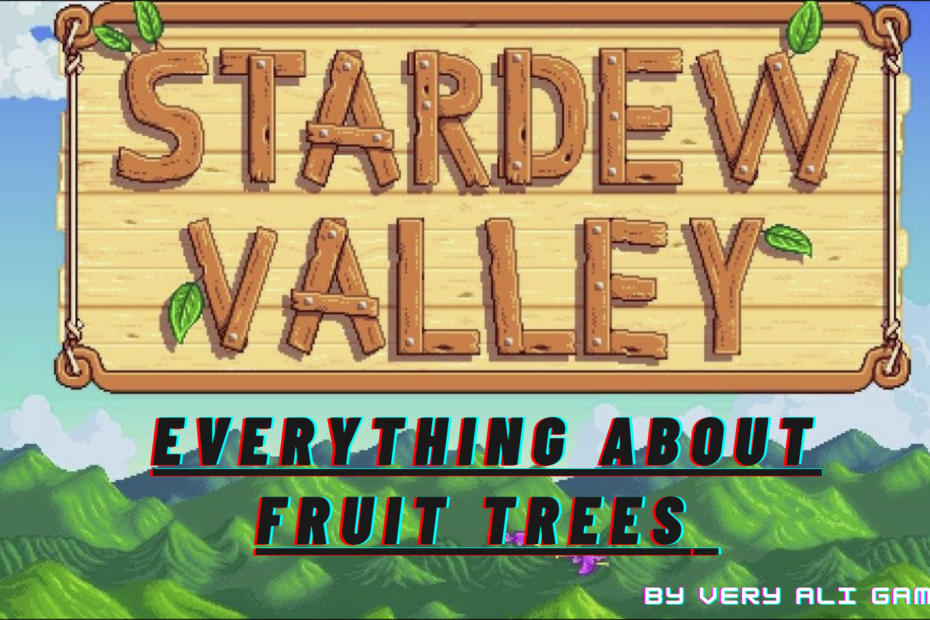Fruit trees are one of the most useful resources you can cultivate in Stardew Valley. Not only do they produce valuable fruits every day after maturity without needing further care, they also continue producing through the winter when most other crops die off.
In this comprehensive guide, we‘ll cover everything you need to know about selecting, planting, and maintaining fruit trees for optimal harvests.
Choosing Fruit Tree Types
There are six types of fruit trees available to plant in Stardew Valley:
- Apple
- Apricot
- Cherry
- Orange
- Peach
- Pomegranate
Each tree takes 28 days to mature initially and then produces one fruit per day during the seasons it bears fruit. Trees do not produce fruits in the winter.
Different fruit trees produce during different seasons:
- Spring – Apricot, Cherry
- Summer – Orange, Peach
- Fall – Apple, Pomegranate
So it‘s useful to plant a mix of tree types to ensure year-round production. The exceptions are if you have access to the greenhouse, which allows trees to produce year-round, or fruit trees planted outside the farm boundaries, which produce during all seasons.
The most profitable fruit trees based on base fruit prices are:
- Peach – 140g
- Pomegranate – 140g
- Cherry – 80g
- Orange – 100g
- Apple – 100g
- Apricot – 50g
However, fruit quality improves each year, dramatically increasing profits. After three years, all fruit trees produce iridium quality fruits worth 2.25 times the base price.
If you plan to process fruits into wine or preserves, the rate of return also varies by fruit type. In summary:
- Apricots produce the most valuable jelly
- Cherries make the most profitable wine
- Pomegranates result in a very valuable juice
So the most profitable fruit tree depends significantly on your plans for using the fruit!
Where to Plant Fruit Trees
Fruit trees must be planted in the outdoor farm in a 3×3 grid with all 8 surrounding tiles open. Over time, the trees will grow to fill these tiles but will not spread beyond the initial 3×3 area.
Many farmers reserve plots along the edges of their farms for orchards. This keeps the trees out of the way of core farming areas while still allowing easy harvests.
However, fruit trees can also be planted:
- In the greenhouse for year-round harvests
- Outside the farm for seasonal harvests without taking up farm space
- Around sheds and other buildings as long as a 3×3 grid remains open
Wherever you choose to plant them, avoid grassy areas which would require clearing before trees could grow. And don‘t plant fruit trees where you may later want to place farm buildings or other objects. While trees can be chopped down if needed, you would lose your investment in the sapling.
Planting and Caring for Saplings
Fruit trees begin as saplings which must be planted and cared for to mature into harvestable trees.
Saplings can be purchased at Pierre‘s General Store for 500g each or randomly dropped from existing fruit trees.
To plant a sapling:
- Clear a 3×3 grid for the sapling
- Use your hoe to till the center tile
- Stand facing the tilled tile and select the sapling from your backpack
- Your character will plant the sapling which will now begin growing
New saplings must be watered daily or they may be destroyed. Mature fruit trees do not require any further care like watering or fertilizing once fully grown.
Each fruit tree takes 28 days to mature before producing its first fruits. After reaching maturity, fruit trees live indefinitely and continue producing fruits every day in season without any further maintenance.
The initial 28 day growth process can be sped up by applying tree fertilizer purchased from Pierre‘s. Each application reduces time to maturity by 7 days.
During lightning storms, fruit trees have a small chance of being struck and destroyed. To protect investments in mature fruit trees, placing a lightning rod nearby will eliminate this risk.
Fruit Tree Harvests and Profits
Once mature, fruit trees produce one fruit per day during the seasons they fruit. Fruits can accumulate on harvested trees for up to 3 days, after which any uncollected fruits will spoil.
The sell price and energy restoration value both depend on the fruit quality:
| Quality | Sell Price Multiplier | Energy Multiplier |
| Normal | 1x Base Price | 1x Base Energy |
| Silver | 1.25x Base Price | 1.5x Base Energy |
| Gold | 1.5x Base Price | 1.5x Base Energy |
| Iridium | 2.25x Base Price | 2.25x Base Energy |
Fruit quality increases after each year of tree growth:
- Year 1: Produces normal quality fruits
- Year 2: Produces silver quality fruits
- Year 3 onward: Produces iridium quality fruits
This increasing fruit quality makes fruit trees become significantly more valuable investments over time. An iridium peach sold directly, for example, will net you 315g per fruit!
Of course, fruits can also be processed into wines, jellies, and juices for additional profits. Some tips:
- Kegs produce fruit wines worth 2-3x the base price of the fruit
- Preserve jars create fruit jellies worth 50% more than the raw fruit
- The seed maker has a small chance of yielding wild tree seeds worth more than iridium fruits
So process fruits whenever your kegs, preserve jars, or seed makers are not being fully utilized!
Over time, a well-tended orchard can become a major source of income, energy restoration, gifting items, and artisan goods processing materials. With some planning, fruit trees can take a significant role in your farm‘s overall production chain.
Just be sure to check back daily during each tree‘s fruiting season to collect and process fruits before they spoil!
